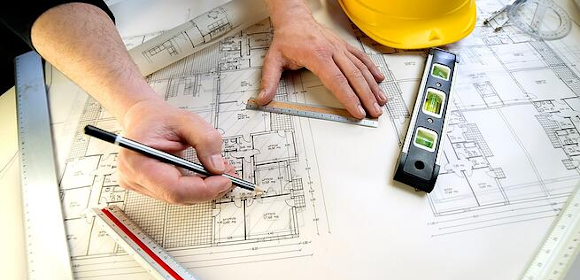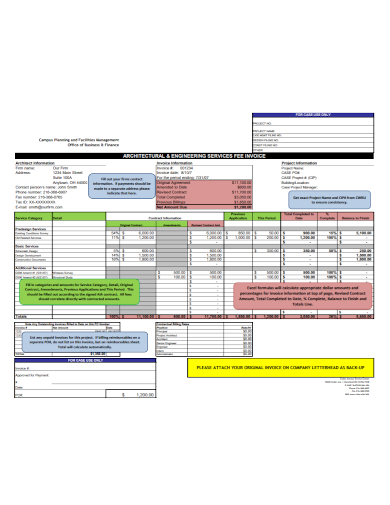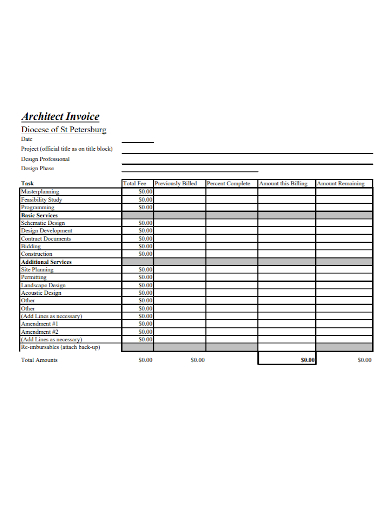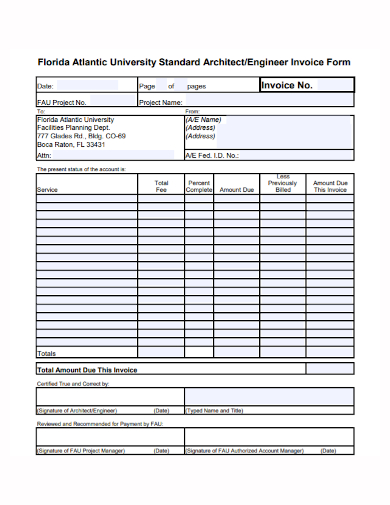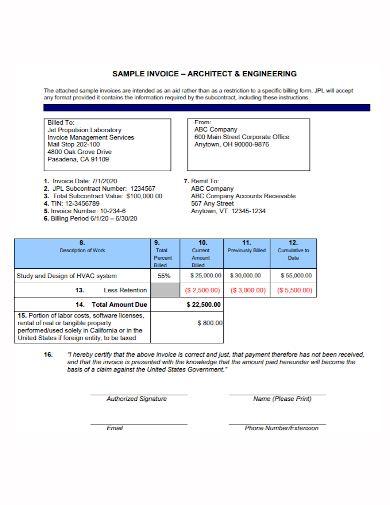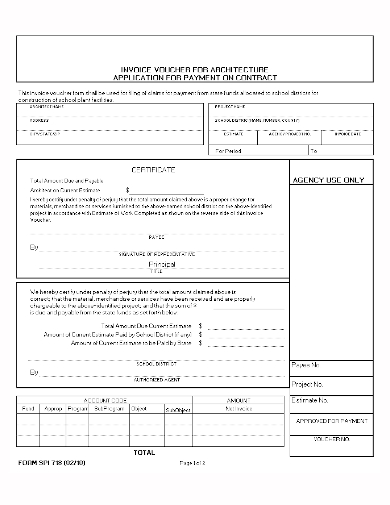An invoice, which is a document that serves to collect payment from customers is used in almost all types of business industries. It is a formal way of billing customers for the products or services that have yet to be availed or have been availed. Like most businesses in the service industry, architectural firms have the need to forward an architecture invoice to their clients. By doing so, clients can go through the details of their transaction, and the payment options. But why is it important for architects to send invoices to their clients? Read more about this in our article below, and if you want to get started working on that invoice, scroll down and check out our free architecture invoice samples.
5+ Architecture Invoice Samples
1. Architecture Invoice Template
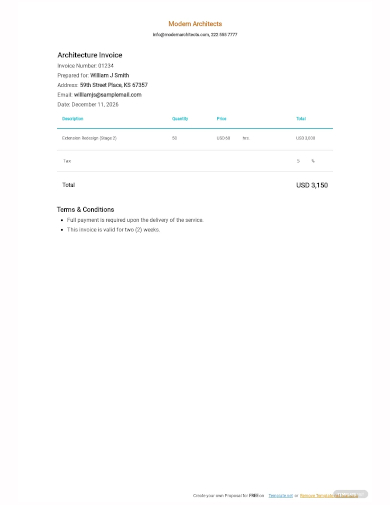
2. Architecture Service Fee Invoice
3. Architecture Task Invoice
4. Architecture Engineer Invoice
5. Sample Architecture Invoice
6. Architecture Voucher Contract Invoice
What Is an Architecture Invoice?
Basically, an architecture invoice is just like any other basic invoice, except for the details. But the main purpose of such an accounting document is to make sure architects are paid for their services. Now, depending on the agreement an architect has with his or her client, invoices are sent to them on a phase or hourly. This is to make sure that the architectural firm has a steady cash flow within the course of the entire project, which can take some time to complete. Also, this invoice can offer verification, in writing, of the payment agreement between your firm and the client. Invoices set your payment terms and enable you to get paid faster for your services.
How To Create an Architecture Invoice?
Some may fail to fully grasp the other benefits of invoices aside from collecting payments. In fact, an invoice can provide other advantages for architectural firms such as:
- Serves as records for all transactions between the company and clients, which may be used in case of any fraudulent lawsuits ensue.
- Helps a company keep tabs on the payments made between the company and clients, in case there is still any remaining balance left.
- For bookkeeping purposes, invoices make a record of all your sales. Invoices provide documentation of your business’s financial history.
- Maintaining a record for easier tax filing.
Now to start working on that architecture invoice, you need to make sure that all the details are correct and clear to your client. So this won’t further any delays most especially if you have meticulous clients who tend to notice discrepancies. Here are the following tips that can help you create an invoice fitting for your architectural firm.
1. Basic Details
Start your invoice with the basic details such as the name of the company, contact details, and address. If you want to add your firm’s license number you may do so as well. Also, add the date the invoice was issued or created, and the payment due date. Don’t forget that each invoice must have a unique sequential code or invoice number. This is to make sure that the income collected is properly documented for tax and accounting purposes.
2. Project Name
Since architects work by project, you need to completely specify the project name and number. This is to make sure your client knows which project you’re billing them for, most especially if you have several other projects with the same client.
3. Client’s Information
Fill in your client’s contact information in order to address them properly.
4. Project Details
Now you will need to go into full detail with the services you have provided to the client, right in the body of the invoice. Add the rates for each service, whether this is a fixed fee or a subtotal based on your hourly rate and number of hours rendered. Or if you and your client have agreed in your contract to bill them by work phase then you can also input the percentage completed as quantity and the total project fee as the price.
5. Tax
As you calculate the total fee, do not forget to add any applicable tax rate.
6. Payment Terms and Methods
Include the agreed payment terms and the methods via bank, cheques, etc. that are agreeable with your firm.
7. Additional Comments and Instructions
You may want to add any additional comments or instructions below the invoice. Perhaps any late charges and the such. If you are sending the invoice via email, you may also attach additional documents relevant to the invoice.
FAQs
What Are The Types of Invoices For Architects?
Architects can use the following invoice: standard or basic invoice, recurring invoice for those working on long projects that can take years to complete, or a pro-forma invoice which is to quote a fee at the beginning of a project and include conditions that will affect the final price. If the project details aren’t yet confirmed, this invoice gives the client an idea of what the final cost will be.
Is It Illegal to Not Pay an Invoice?
Paying an invoice will depend on the prior terms let’s say in the contract between you and the client. A company has a right to impose late fees for unpaid invoices or if they still refuse to do so, you can take your case to court.
What Is Another Term for Unpaid Invoice?
This may be called an overdue invoice, where one company has yet to pay and is past the invoice due date. Remember it is advisable to charge clients for a late penalty.
As an architect, you want to make sure that your client would pay on time, so it is important that the invoice is complete and detailed. So start working on that architecture invoice now. And if you need any samples, don’t forget to check our free sample templates right in the article.
Related Posts
FREE 8+ Business Consultant Invoice Samples in PDF
FREE 10+ Conference Invoice Samples in PDF
FREE 10+ Consultant Invoice Samples in PDF
FREE 10+ Sample Invoice for Consulting Services in PDF
FREE 3+ Cake Invoice Samples [Wedding, Birthday, Order]
FREE 10+ Payment Invoice Samples in MS Word | MS Excel | Google Docs | Google Sheets | PDF
FREE 9+ Agriculture Invoice Samples in MS Word | MS Excel | Google Docs | Google Sheets | PDF
FREE 10+ Work Invoice Samples in MS Word | Google Docs | Google Sheets | MS Excel | PDF
FREE 10+ Professional Invoice Samples in MS Word | Google Docs | Google Sheets | MS Excel | PDF
FREE 10+ Cleaning Invoice Samples in MS Word | Google Docs | Google Sheets | MS Excel | PDF
FREE 6+ Massage Invoice Samples in MS Word | MS Excel | Google Docs | Google Sheets | PDF
FREE 10+ Work Order Invoice Samples in MS Word | MS Excel | Google Docs | Google Sheets | PDF
FREE 5+ Legal Service Invoice Samples in MS Word | MS Excel | Google Docs | Google Sheets | PDF
FREE 10+ Hourly Invoice Samples in PDF | MS Word | Google Docs | Google Sheets | Excel
FREE 10+ Customer Invoice Samples in MS Word | MS Excel | Google Docs | Google Sheets | PDF
